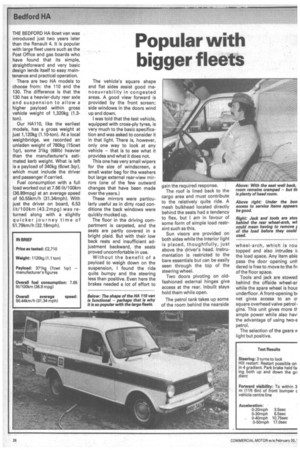Popular with bigger fleets
Page 20

If you've noticed an error in this article please click here to report it so we can fix it.
THE BEDFORD HA 6cwt van was introduced just two years later than the Renault 4. It is popular with large fleet users such as the Post Office and gas boards who have found that its simple, straightforward and very basic design lends itself to easy maintenance and practical operation.
There are two HA models to choose from: the 110 and the 130. The difference is that the 130 has a heavier-duty rear axle and suspension to allow a higher payload within gross vehicle weight of 1,320kg (1.3ton).
Our HA110, like the earliest models, has a gross weight at just 1,120kg (1.10-ton), At a local weighbridge, we recorded an unladen weight of 780kg (15cwt 1qr), some 31kg (681b) heavier than the manufacturer's estimated kerb weight. What is left is a payload of 340kg (6cwt 3gr), which must include the driver and passenger if carried.
Fuel consumption with a full load worked out at 7.66 lit/100km (36.89mpg) at an average speed of 50.55km/h (31.34mph). With just the driver on board, 6.53 lit/100km (43.2mpg) was returned along with a slightly quicker journey time of 51.79km/h (32.18mph).
The vehicle's square shape and flat sides assist good manoeuvrability in congested areas. A good view forward is provided by the front screen; side windows in the doors wind up and down.
I was told that the test vehicle, equipped with cross-ply tyres, is very much to the basic specification and was asked to consider it in that light. There is, however, only one way to look at any vehicle — that is to see what it provides and what it does not.
This one has very small wipers for the size of windscreen, a small water bag for the washers but large external rear-view mirrors (one of the few outward changes that have been made over the years.) These mirrors were particularly useful as in dirty road conditions the back windows were quickly mucked up.
The floor in the driving compartment is carpeted, and the seats are partly covered in a bright plaid. But with their low back rests and insufficient adjustment backward, the seats proved uncomfortable in use.
Without the benefit of a payload to weigh down on the suspension, I found the ride quite bumpy and the steering less than positive. Even here the brakes needed a lot of effort to gain the required response.
The roof is lined back to the cargo area and must contribute to the relatively quite ride. A mesh bulkhead located directly behind the seats had a tendency to flex, but I am in favour of some form of simple load restraint such as this.
Sun visors are provided on both sides while the interior light is placed, thoughtfully, just above the driver's head. Instrumentation is restricted to the bare essentials but can be easily seen through the top of the steering wheel.
Two doors pivoting on oldfashioned external hinges give access at the rear. Inbuilt stays hold them while open.
The petrol tank takes up some of the room behind the nearside wheel-arch, which is rou topped and also intrudes ii the load space. Any item able pass the door opening unh dered is free to move to the fn of the floor space.
Tools and jack are stowed behind the offside wheel-ar while the spare wheel is hou5 underfloor. A front-opening bi net gives access to an o, square overhead valve petrol gine. This unit gives more th ample power while also havi the advantage of using two-s petrol.
The selection of the gears v light but positive.


















































